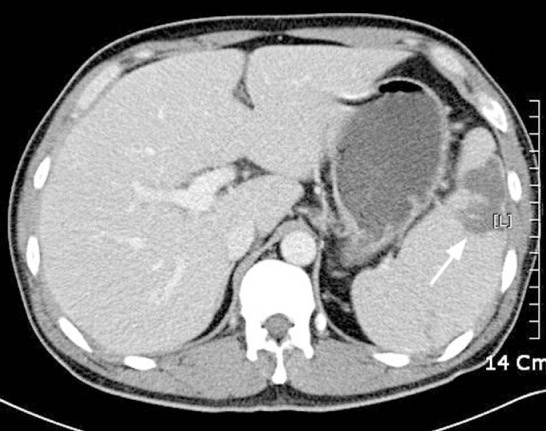Infect Chemother.
2010 Feb;42(1):48-50. 10.3947/ic.2010.42.1.48.
Splenic Infarction Associated with Brucellosis in a Non-Endemic Area
- Affiliations
-
- 1Department of Internal Medicine, Wonkwang University College of Medicine, Iksan, Korea. john7026@wonkwang.ac.kr
- KMID: 2170281
- DOI: http://doi.org/10.3947/ic.2010.42.1.48
Abstract
- A 45-year-old man was referred from a local clinic with persistent fever, intermittent pain in the left upper abdomen, and weight loss of 7 kg. He quit his animal husbandry 18 months ago when his cows were found to be infected with Brucella. Abdominal computed tomography (CT) scan taken on admission showed splenomegaly with a wedge-shaped hypoattenuating region in the enhanced image, which was consistent with splenic infarction. Serology for Bruculla was strongly positive with the standard tube agglutination test (1/2560). After initiation of doxycycline (100 mg every 12 hrs) and rifampin (600 mg every day), the patient's condition improved, and was discharged with oral antibiotics that were to be continued for 3 months. During the 12 months' follow up at the outpatient department, the patient had no symptoms, and the last agglutination titer for Brucella in serum had decreased to 1/40. To our knowledge, this is the first report on splenic infarction associated with brucellosis in Korea, which was treated successfully with antibiotic therapy.
Keyword
MeSH Terms
Figure
Reference
-
1. Young EJ. An overview of human brucellosis. Clin Infect Dis. 1995. 21:283–289.
Article2. Reguera JM, Alarcón A, Miralles F, Pachón J, Juárez C, Colmenero JD. Brucella endocarditis: clinical, diagnostic, and therapeutic approach. Eur J Clin Microbiol Infect Dis. 2003. 22:647–650.3. Kim YS, Sill CY, Oh WS, Kwon KT, Lee H, Lee SH, Son JS, Kim SW, Chang HH, Jung SI, Ko KS, Park MY, Peck KR, Song JH. Clinical characteristics of human brucellosis in South Korea. Infect Chemother. 2006. 38:334–343.4. Park SH, Choi YS, Choi YJ, Cho SH, Yoon HJ. Brucella endocarditis with splenic abscess: a report of the first case diagnosed in Korea. Yonsei Med J. 2009. 50:142–146.
Article5. Kang YU, Jung YS, Park KH, Jung SI, Shin JH, Anh BH, Ko KS. A case of Brucella endocarditis with spondylitis in a patient with multiple myeloma. Korean J Med. 2008. 74:561–565.6. Je HG, Song H. Brucella endocarditis in a non-endemic country: first reported case in East Asia. Circ J. 2008. 72:500–501.
Article7. Cakalagaoglu C, Keser N, Alhan C. Brucella-mediated prosthetic valve endocarditis with brachial artery mycotic aneurysm. J Heart Valve Dis. 1999. 8:586–590.8. Zaidan R, Al Tahan AR. Cerebral venous thrombosis: a new manifestation of neurobrucellosis. Clin Infect Dis. 1999. 28:399–400.
Article9. Salgado F, Grana M, Ferrer V, Lara A, Fuentes T. Splenic infarction associated with acute Brucella mellitensis infection. Eur J Clin Microbiol Infect Dis. 2002. 21:63–64.
Article10. Yaqupsky P. Detection of Brucella in blood cultures. J Clin Microbiol. 1999. 37:3437–3442.11. Ariza J, Pellicer T, Pallarés R, Foz A, Gudiol F. Specific antibody profile in human brucellosis. Clin Infect Dis. 1992. 14:131–140.
Article12. Joshi SC, Pant I, Shukla AN, Anshari MA. Splenic infarct as a diagnostic pitfall in radiology. J Cancer Res Ther. 2008. 4:99–101.
Article13. Rabushka LS, Kawashima A, Fishman EK. Imaging of the spleen: CT with supplemental MR examination. Radiographics. 1994. 14:307–332.
Article14. Noval J, Nuño FJ, Bustamante JF, Baró U. Splenic infarction in a patient with anticardiolipin antibodies and leptospirosis. Enferm Infecc Microbiol Clin. 1999. 17:98–99.15. Solera J, Martinez-Alfaro E, Espinosa A. Recognition and optimum treatment of brucellosis. Drugs. 1997. 53:245–256.
Article
- Full Text Links
- Actions
-
Cited
- CITED
-
- Close
- Share
- Similar articles
-
- Brucellar Spondylodiscitis in an Endemic Bovine Brucellosis Region of Korea: A Case Report
- Hypotensive Splenic Infarction: A Case Report
- The Pathologic Splenic Rupture of a Patient with Scrub Typhus: A Case Report
- A Case of Acute Pancreatitis and Splenic Infarction Associated with Antiphospholipid Syndrome
- Isolated Splenic Infarction in a Girl with Systemic Lupus Erythematosus


